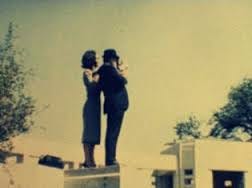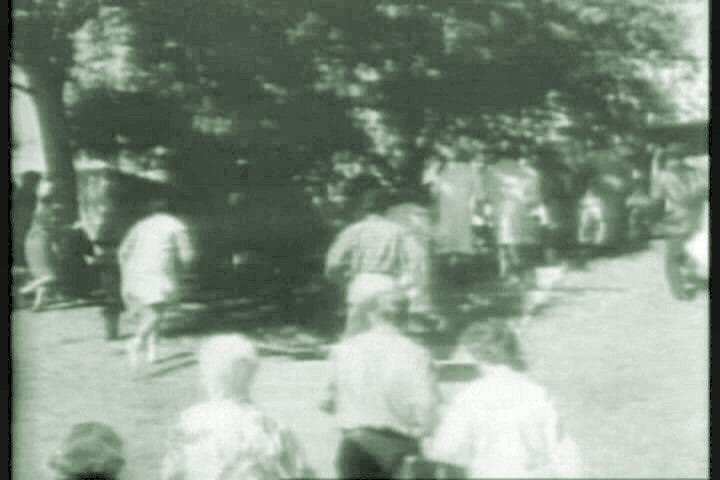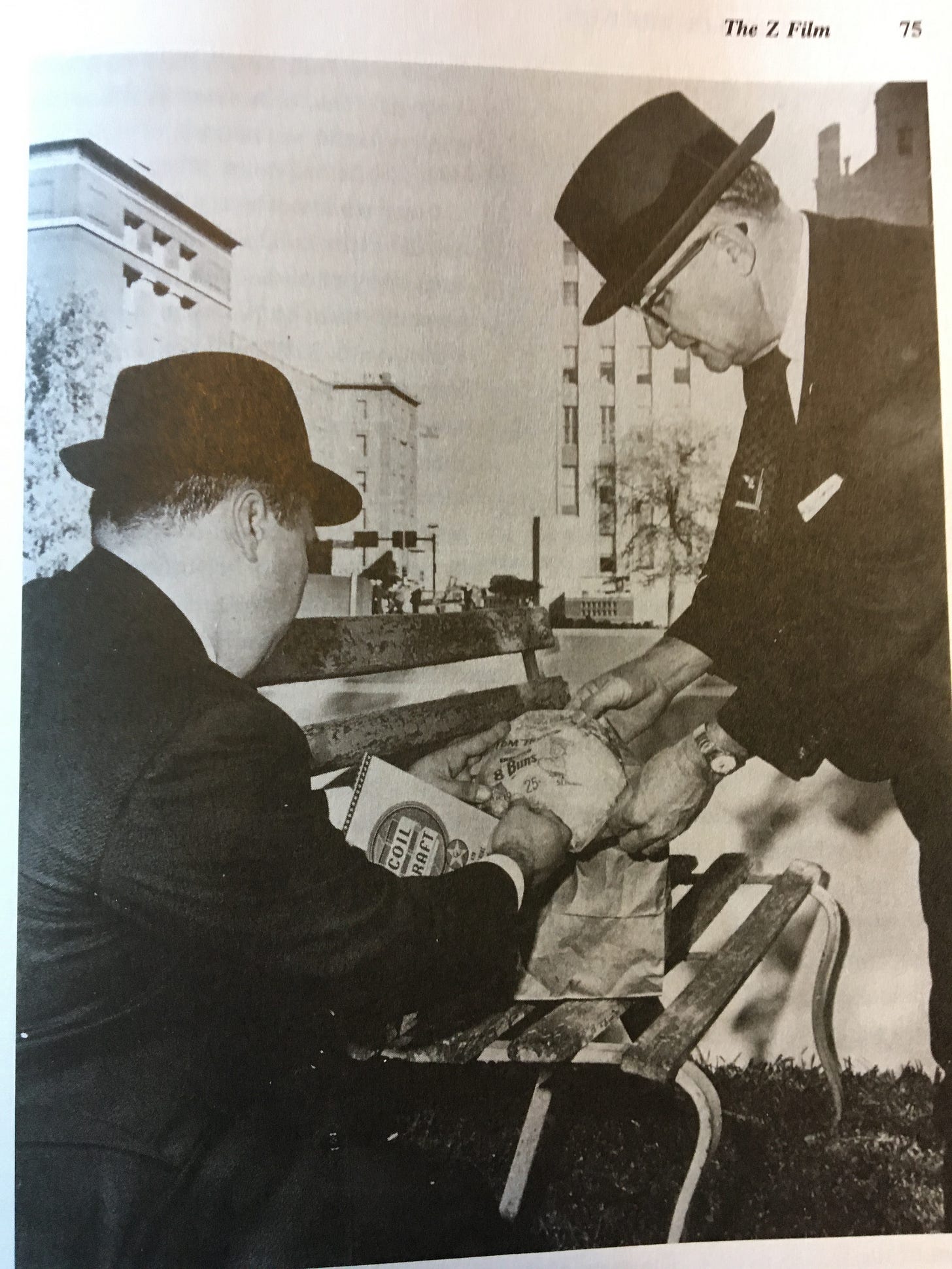Black History Mystery: Two African-Americans on the Grassy Knoll
They saw JFK gunned down. They were banished from history.

[This is an updated version of a story I first published in 2014.]
A little over sixty years ago, two young black people in Dallas found themselves eyewitnesses to the assassination of President John F. Kennedy — yet their voices have never been heard. Indeed, more than a half century later, even their names are unknown. In the annals of black history, they are one hell of a missing page.
These two young people sat in Dealey Plaza, in the vortex of history, in that very small, very famous piece of real estate immortalized in the phrase "the grassy knoll,” in that heart-stopping moment that novelist Don DeLillo dubbed “the six seconds that broke the back of the American century.” If you go to Dallas today, you can see the spot almost exactly — but not quite — as it was on the day of JFK’s assassination.
Seated on a park bench, this young woman and her male companion had a hamburger lunch and a front row seat on the making of history. They might have been students at Bishop College, a historically black school in Dallas at the time. One bystander thought they were a couple. Since we don’t know their real names, let’s call them Larry X and Mary Y. They came to see JFK and Jackie in person. They witnessed a nightmare.
How We Know the Story
"There was a colored couple. I figure they were between 18 and 21, a boy and a girl, sitting on a bench, just almost, oh, parallel with me, on my right side, close to the fence," recalled Marilyn Sitzman, another spectator in the crowd in downtown Dallas.
Sitzman had accompanied her boss, dressmaker Abraham Zapruder to Dealey Plaza to watch President Kennedy's mid-day motorcade. They found a spot on a marble wall atop a grassy embankment overlooking the parade route. Sitzman steadied Zapruder as he filmed the approaching motorcade. With his Super 8 movie camera , Zapruder captured the killing of the president.

In a 1966 interview, Sitzman told author Josiah Thompson that she had first noticed the black couple 10 or 15 minutes before JFK's arrival.
"Everybody was milling around down there, trying to find a place to stand and everything," she recalled, "and I know when we went over to get up on the marble thing, they were already sitting there. … They were eating their lunch, 'cause they had little lunch sacks, and they were drinking Coke.”
If Larry X and Mary Y were on a date, the day was cooperating. An early morning rainstorm had passed. By lunchtime the sun had come out and it was a perfect afternoon to cheer the President and First Lady. While JFK was reviled by many white people in Dallas for his liberal policies, he was popular among young black people for his eloquent call for civil rights legislation, not to mention his stylish wife.
As Larry and Mary watched the presidential motorcade pass by, seventy five feet in front of where they sat, a series of gunshots rang out. Kennedy was jolted by a bullet in the back and then then flung violently backward by a bullet that struck his head above his right ear blasting his skull open in an explosion of blood that spattered Jackie’s pink dress while spectators screamed in horror.
In the ensuing chaos, Sitzman saw the black couple again.
"The main reason I remember 'em is, after the last shot I recall hearing and the [president's] car went down under the triple underpass there, I heard a crash of glass, and I looked over there, and the kids had thrown down their Coke bottles, just threw them down and just started running towards the back, and ... everybody else was running that way."
Larry and Mary escaped the crime scene as fast as they could.
Running Man
Secret Service agent Paul Landis also saw Larry.
Riding in the car behind JFK’s limousine, Landis sensed that the fatal shot came from “somewhere towards the front” of the motorcade. In a statement given a few days later, Landis said he saw “a negro male in light green slacks and a beige-colored shirt running across a grassy section towards some concrete steps. … He was in a bent over position.”
No other African-American male is known to have been standing in that area at the time of the assassination. Photographs of the grassy knoll area taken thirty seconds after the gunfire show no sign of the young black couple. The well-dressed young man, running “bent over,” might have been ducking from the gunfire erupting from the behind the stockade fence.
Landis lost sight of Larry. Sitzman didn't see "the kids” again. No one did.
The real names of Larry and Mary have never been found. They were never identified or interviewed by any law enforcement officer or investigator. No journalist, historian, or author ever found them. No one in the virtually all-white community of JFK researchers even expended much effort to find them. Outside of Josiah Thompson’s “Six Seconds in Dallas,” they do not exist in the vast literature of JFK's assassination. They were present at the scene of an epic crime — and they vanished.
It might be more accurate to say they were banished.
What Did They See?
As witnesses to one of the greatest crimes of the 20th century, Larry and Mary were well situated. The park bench where they sat overlooked Elm Street. It was the spot that Merriman Smith, a newspaper reporter on the scene, dubbed “grassy knoll.”
Smith was riding in the press car in the motorcade. After the sound of gunfire, they followed JFK’s limousine to Parkland Hospital. Smith jumped out, talked to some of Secret Service men on the scene, and then went to a pay phone where he dictated a news story to his editors at United Press International in New York. Within minutes Smith’s dispatch went out to hundreds of newspapers and radio stations around the country.
Soon millions of stunned Americans were hearing the UPI report, as read by announcers and anchormen.
"Some of the Secret Service agents thought the gunfire was from an automatic weapon fired to the right rear of the president's car, probably from a grassy knoll to which police rushed."
The UPI story proliferated in special editions of newspapers around the country. Smith had coined an immortal phrase: grassy knoll.
And bystander testimony buttressed his report. At least 34 witnesses would come forward to say they thought a gunshot had been fired from the grassy knoll. A more comprehensive survey found 52 witnesses who said they heard a shot from the area.
That’s right where Larry X and Mary Y were sitting. But when I checked these compilations, I found no account from a young black man or young black woman.

What They Left Behind
Luckily, the details of Marilyn Sitzman's story and Paul Landis’s account are corroborated by a photograph found in a book called “Pictures of the Pain,” compiled by photo archivist Richard Trask.

The photo, taken an hour after JFK's assassination, shows the park bench that Sitzman mentioned. It shows two Dallas police detectives looking at the remains of a bag lunch — which Sitzman saw.
… they were already sitting there. … They were eating their lunch, 'cause they had little lunch sacks, and they were drinking Coke.
Another photograph shows a bottle of soda on the retaining wall. A third shows a pool of soda pop on the ground — which Sitzman saw.
… the kids had thrown down their Coke bottles, just threw them down and just started running towards the back.
So there definitely was a young African-American couple on the knoll that day. Larry X and Mary Y. were certainly eating lunch. They obviously saw the assassination of JFK. They undestandably ran away. And, tragically, they have never been heard from since.
Larry and Mary might — just might — still be alive to tell their story. If Sitzman was right about their ages, Mary would be in her late 70s now. The average life expectancy of African-American women is 76.1 years.
Why Didn't They Come Forward?
We never heard from Larry X or Mary Y for obvious reasons.
In 1963, Dallas was a Jim Crow city where African-Americans were routinely treated as second-class citizens, especially by law enforcement. When Dallas police interviewed witnesses to the assassination, they asked African-Americans if they had ever been in trouble with the law.
These two young people had no good reason to tell anyone in a position of authority what they saw in Dealey Plaza. After accused assassin Lee Harvey Oswald — who denied shooting JFK — was murdered in police custody, it might have been dangerous for them to come forward.
It made sense to keep their story to themselves. But what a story. Their experience that day goes to the very heart of American history. Either they were in the line of fatal gunfire on Nov. 22, 1963, or not.
What did Mary and Larry see on November 22? Its hard to believe they didn’t share what they knew with someone. It’s easy to believe they were too terrified to talk.
I put the question to Don Roberdeau, a Navy veteran and JFK researcher who has mapped the location of every Dealey Plaza witness. He replied via email.
"For me, one of the black couple simply threw down his/her pop bottle after the shock of seeing President Kennedy bloodily executed only 75 feet away. Someone, maybe the other black person, set his/her pop bottle atop the retaining wall, they left their hamburgers bag behind, and they both just went off into the [Texas School Book Depository] parking lot, choosing never to come forward, nor have they been identified publicly — for whatever reasons. My guess is that they both sensed the nearby fired shot. One or both of the black couple saw the ... picket fence assassin who was only forty feet southwest of the sitting bench."
In other words. These black folks might have seen JFK’s assassin.
Or maybe not. Whatever they saw, it was consequential. If the fatal shot came from a gunman behind the fence, they could have sniffed the muzzle blast. Conversely, if, as the official theory is right, all the gunfire came from the sixth floor of the Texas School Book Depository, several hundred feet to their left, they were well-positioned to confirm the story of a lone gunman.
Their experience, while crucial, is perhaps unknowable. And maybe it is unwanted.
Here’s a telling detail: Dealey Plaza is a national historic monument, whose historic character must be preserved for future generations. One of the very few things that has changed over the last six decades is the spot where the young African-American couple sat. The park bench from which Larry and Mary saw JFK’s murder has been removed. Not just their story, but even the perch of their experience has been effaced from public view.
And Yet
Or perhaps their story is not lost forever. I have been writing about “the couple on the knoll” on JFK Facts for a decade now. I’ve put out queries to friends and acquaintances from Dallas, so far without results. I regularly receive photos and documents and from people with interesting, original information about the JFK story. Every week JFK Facts publishes memories of November 22. Maybe somebody will write to say, “I knew Larry X” or “Mary Y was my auntie” or “We had a story like that in our family.”
I’m still hoping the story of the couple on the knoll will one day be written into black history — and into American history.






First rate. I’d love to think that this story is percolating somewhere. And that there were no odd deaths corresponding to a possible “Larry & Mary”…
Jefferson, This was another outstanding article! Quite thought-provoking as well!